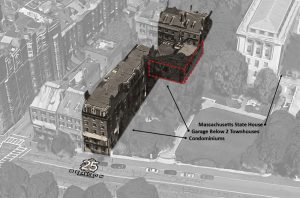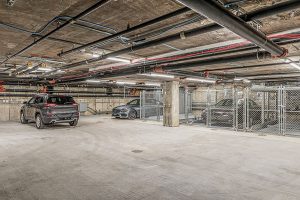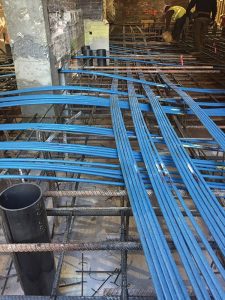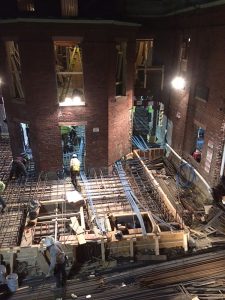Top-Down, Post-Tensioned Concrete Solution Drives Success in Boston
The picturesque Beacon Hill conservation area in Boston is home to some of the most historic and prestigious buildings in the city. The area is characterized by narrow streets and Federal-style façades that are protected as part of Boston’s rich heritage.
This was the challenging location for a project involving the conversion of two townhouses – numbers 6 and 7 Mount Vernon – into luxury 21st-century properties, along with a building to the rear which was converted into luxury condos. Sea-Dar Construction was the general contractor for the project. The developer’s vision was to create a parking basement for the renovated properties by excavating beneath the two townhouses while preserving the existing above-ground structure.
The Challenges
The plan for a basement parking lot was viewed as the ideal solution to provide parking spaces. Due to the limited space of the location and the restrictions on any exterior modifications to the properties because of their conservation area location, restrictions had been placed on creating exterior, ground-level parking.
The underground parking solution presented numerous challenges, however. While plans for the townhouses included internal remodeling, there was a project-critical requirement to retain the façades and some of the internal structural walls, so it was vital that the excavations did not cause any adverse structural movement. Moreover, the buildings share structural walls with neighboring properties and are sandwiched between the Parkman House, where the Mayor of Boston entertains guests, and the gold-domed Massachusetts State House. Consequently, any movement or structural damage caused by the excavations would affect these buildings too.
The location also involved design and buildability challenges. Modifications to the external aspect of the properties had to be ‘in keeping’ with the local architectural context and original design, and the narrow streets severely restricted vehicle movements, size of the equipment, and any cranage requirements.
The underground parking lot was designed with a ground-level entrance and a vehicle elevator to accommodate the heritage restrictions. The engineering and construction team needed to develop a solution that would avoid structural movement and support the structure above both during the excavations and post-construction. The design also had to overcome the logistical restrictions and enable large spans to allow 14 parking bays and associated vehicle movement.
Initial Proposals
The initial parking garage design proposed the use of structural steel beams to hold the existing structure in place. This required installing the beams after the structure had been temporarily shored by carrying out an extensive needling process of the existing structural brick walls and underpinning of the existing foundations to allow for the excavation. It was clear that this initial plan did not take into consideration the implications of the structure’s integrity, the significant logistical constraints, or the project schedule.
Needling through existing old brick structural walls would have been very risky. Also, the weight of the structural steel beams would have made it close to impossible to get them into the building and maneuver them into position.
The time and cost implications were extremely onerous. Sea-Dar Construction estimated that the underpinning works alone would take up to six months, and there was likely to be a wait and a cost premium for the right expertise. Added to those program and labor costs was the excessive price of the steel itself, due to the weight and number of structural beams required.
Finally, there was a significant design issue. Due to the depth of the steel members and the height clearance needed for the basement, the initial design proposal would also have required deeper excavations.
A New Approach
Sea-Dar Construction began brainstorming alternative approaches and proposed a top-down construction program that would enable the above-ground structure to be supported without underpinning during the excavations. A post-tensioned slab was the obvious answer, and Sea-Dar Construction brought in CCL to advise on feasibility and design a suitable solution.
It became clear that, by combining mini piles with a flat post-tensioned transfer slab tied into the structural walls, the above-ground structure could be supported both during the excavation and post-construction, in addition to providing the large span required for an open-plan basement with just two support columns. This option overcame the logistical issues of transporting large pieces of steelwork and heavy equipment to the site, offered a much faster construction schedule, and reduced excavation depth and the cost of materials.
As the major structural risk element of the construction process was the excavation of the parking basement, a top-down approach was an ideal way to protect the façade and adjoining buildings, as the excavation would be carried out after the post-tensioned slab was already in place, enabling it to support the above-ground structure and brace the retaining elements.
Build Methodology
The original wooden ground-level floor was removed, an opening was created in the wall to enable the piling works, and closely drilled mini piles were drilled around the internal perimeter of the external wall. These piles were specified to enable post-excavations of 10 feet of headroom for the parking garage – while further anchoring into the ground.
The idea was to brace the top of the piles with a post-tensioned slab, providing a structure that could support the force of the earth during the excavations and carry the weight of the existing above-ground structure.
To tie the post-tensioned slab into the existing structure, small openings were created in the existing load-bearing brick walls at regular intervals at the height of the proposed slab, creating a castellated effect with gaps in the brickwork for concrete.
The size and location of these openings were modeled by the CCL team to ensure that the risk of structural wall movement and deflection of the slab were managed. All structural walls were also monitored throughout the work to corroborate the expected design values. Extensive hand calculations were performed to verify the feasibility and demonstrate to the project’s Engineers of Record that the solution would deliver against all structural and risk management considerations.
With the castellated openings in place, the steel reinforcement was installed into the brickwork and through the gaps. The positioning of the longitudinal and latitudinal post-tensioning tendons was also carefully mapped out, and post-tensioning tendons were crossed through the wall openings, ensuring that post-tensioning of the slab was tied into the existing structure.
The concrete pour was carried out in two phases, filling some of the wall openings with concrete before casting the remaining with the inter-connecting slab. When all the concrete had cured to the required strength, the tendons were post-tensioned, resulting in a self-supporting slab that was fully connected and running through the existing walls. Excavations could then begin, with earth and all foundations of the existing structure removed from underneath the post-tensioned slab, creating the new level space that would later become the parking garage.
Shotcrete walls were created around the perimeter of the excavated area connecting the (now exposed) upper third of the mini piles and ensuring a permanent and effective retaining structure. Foundation walls and the basement slab-on-ground were then finally put in place.
Maximizing Space
One of the early ideas was to have a U-beam underneath the slab to embrace the walls and thereby avoid movement of the structure above. This proposal entailed the loss of space, reducing vehicle clearance. After rigorous calculations and modeling, and the idea of intertwining the post-tensioned slab with the existing walls, CCL was able to present a two-way post-tensioned transfer slab solution that provided adequate capacity to support the self-weight and the movements of the above-ground structure while allowing for top-down construction. This was very appealing to the project team because it left an open-plan parking garage with limited drops and just two columns, essentially yielding a transfer slab of 32-foot spans intertwined with the existing walls.
Summary of Advantages
Thanks to the creative thinking and collaborative approach of the project team, the project was not only viable from a cost and buildability perspective but also enhanced the spatial effectiveness of the newly-excavated basement.
In total, the change in approach reduced the time required to create the basement parking lot by around six months and avoided the need for any fire protection installation as the post-tensioned slab already met the required fire rating.
An extremely unusual project with some particular challenges, this small underground parking lot demonstrates the viability of a top-down approach to basement excavation using post-tensioned concrete, which could be replicated to resolve similar challenges for other confined site projects and heritage buildings.■




